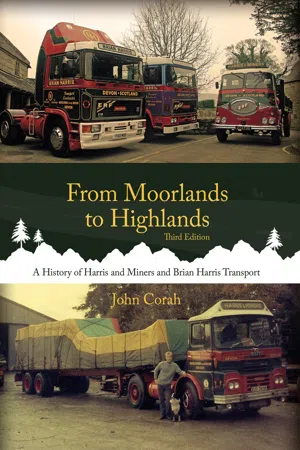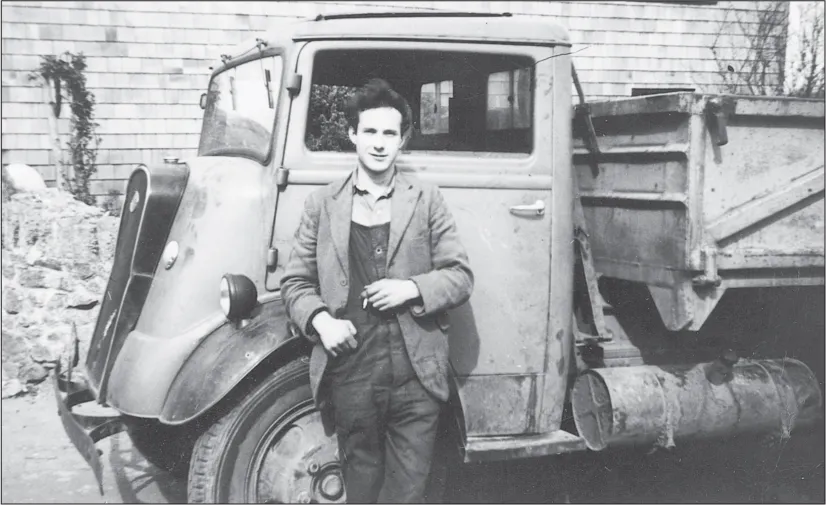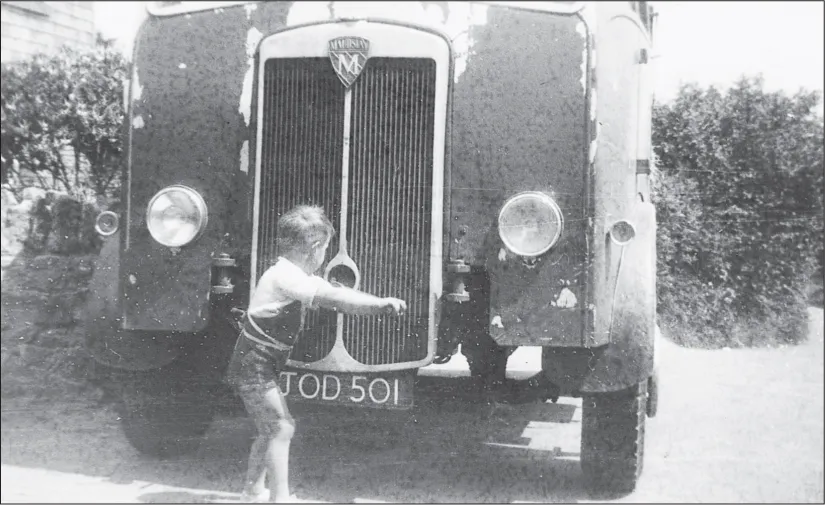![]()
Chapter One
THE BIRTH OF A MOORLAND HAULAGE COMPANY
Most businesses have a humble beginning somewhere and Harris & Miners is no different. The biggest road transport firms have mostly started with one man and one vehicle and many can trace their roots back to the horse and cart. I am not sure about the horsepower in the case of this company, but we certainly start our story with one man and a lorry back in 1936.
Harris & Miners was a Devon concern through and through, with its roots firmly planted in the middle of Dartmoor. Widecombe-in-the-Moor to be precise. However, it is to North Devon that we have to go to start the story. It was in Atherington that one of the co-founders was born in 1910. Sydney Harris was to form a partnership with his brother-in-law, Sam Miners, in 1941 but he had already begun a haulage business in 1936 while living in Bow in mid-Devon. By the time Harris & Miners was on the map no-one knew a Sydney Harris as he was always known as Jerry! So it was then that Jerry Harris bought his first lorry in 1936, a second-hand Dennis for £179. £30 of his own money and £149 from Bowmakers. With this lorry came a ‘B’ Licence, which gave him the licence to carry customers’ goods with certain restrictions.
Any haulier had to have an ‘A’, ‘B’, or ‘C’ Licence to be able to operate and this situation continued for many years after the Second World War. The ‘A’ Licence was for general haulage; the ‘B’ Licence was general haulage but with restrictions; and the ‘C’ Licence for the carriage of your own goods only. The only way to get these licences was to apply to the courts which would invariably be opposed by other hauliers, or to buy a lorry with a licence. Any old lorry would do as the licence was all-important and could be transferred to another.
In 1939 Jerry moved to Widecombe and lodged with his sister, who had married Sam Miners. His new brother-in-law, Sam, worked with his brother Bill Miners in an already established haulage company by the name of W.F. Miners. Jerry joined them as a driver for a while until he branched out on his own again in 1946 and was joined by Sam Miners to form Harris & Miners. Sam left his brother Bill, who continued to trade as W.F. Miners and Sons, and there the relationship between W.F. Miners and Harris & Miners ends. Jerry Harris was not required for war service as a gammy foot, as a result of a previous motoring accident, rendered him medically unfit. H & M started with three lorries comprising two Fords and a Commer tipper. The Fords were V8 petrol engined and the Commer a straight-6 sidevalve. Sand, timber, and fruit from Avonmouth Docks being the main loads in those days.
In 1942 Jerry married Margaret Nosworthy from Venton, near Widecombe-in-the-Moor. In a small village like Widecombe, tucked away on Dartmoor, everyone knew everyone and without private transport and a limited public transport system (the Haytor Bus Service provided by Potters of Ilsington), the social life centered around the village hall for the locals. It was at a Saturday night dance in the hall that the two met. Margaret was a farmer’s daughter who was most adept at breaking horses and who prided herself on being able to ride anything. The local nurse had a horse to get round her patients on the Moors which was broken in by Margaret. The wedding reception was held at the Wayside Café in Widecombe after a church service at the Parish Church. The Harvey family then owned the café and offered the reception free of charge as Margaret’s mother had been a mother to them after their own parents had died. Jerry and Margaret first set up home in one of the church cottages at Dunstone on the edge of Widecombe. A little further along the road was a row of council cottages in which lived Bill Miners at one end and Sam Miners at the other. In 1943 Brian was born. The Reverend Woods christened Brian at Widecombe Parish Church; he had also christened Margaret and married Jerry and Margaret. In those early days the lorries ran out of Widecombe and the administration remained in Widecombe throughout the life of the company. A small, tightly knit community tucked away on Dartmoor had spawned not one, but two haulage companies. W.F. Miners, (who operated out of Ashburton), and Harris & Miners.
Trago Mills, a large retail outlet near Newton Abbot, stands on the site from where the sand was extracted that Harris & Miners started to haul and keep a lorry or two. Caunters sand pit was also not far from Candy and Company of Heathfield, who were manufacturers of tiled fireplace surrounds and Candy Tiles. In 1947 Harris & Miners got their first long distance customer and started a business relationship with Candy that was to last for fifty years. Up until then all their production had been sent by rail from Candy’s sidings at Heathfield, a branch of the Newton Abbot to Moretonhampstead line. Heathfield was also a railway junction with another line going up the Teign Valley to Longdown and on to Exeter. Jerry and Sam went to see Mr. Leffbridge in his office at Candy and were offered a test load of fireplace surrounds on one of their lorries to see if road could compete with rail! That load proved the making of Harris & Miners and not only proved that road haulage was quicker and cheaper than rail (even as far back as 1947), but turned Jerry’s and Sam’s company into a serious long distance fleet, reaching Glasgow with a load of ‘Devon Grate’ Candy fire surrounds for the first time in 1948. It took a week to get there but was still presumably quicker than a steam train!
Thus begun a connection between Devon and Scotland that was to be the backbone of H & M for as long as the company operated. Initially the lorries had ‘B’ Licences for the transport of Candy products anywhere, and general haulage restricted to Devon, Cornwall, Dorset, and part of Somerset; but nobody told them which part! Back loads were found from north of the border and a flourishing two-way traffic developed with many Scottish customers being taken on board. Such became the respect for the company that when Jerry died in 1978 the mourners at the Parish Church in Widecombe-in-the-Moor included many from Scotland, and several again turned up for the auction in 2001. In 1948 Mick Whiteway joined Jerry and Sam as a driver having just left the Army in March. He joined them in the following June having walked from Buckland-in-the-Moor, (Mick’s aunt was also a Nosworthy), to Widecombe-in-the-Moor to see Jerry about a job. He was then 21 years old and remained with the company until retiring in 1992. There was, however, a four years break of service from 1950 to 1954 caused through no fault of his own but enforced by His Majesty’s government – nationalisation.
Bill Baty was already with the company having started at the age of 19 at the end of 1946. He remained close to the business throughout. He also had a four years gap as a result of nationalisation, and was persuaded back by Jerry Harris in 1954 over a pint at the Rugglestone Inn, Widecombe-in-the-Moor. He became traffic manager in 1960 and left to start his own business when Brian “came off the road” in 1965. He continued, however, to operate from the Pottery Road depot and long after retirement was still doing a bit of driving for Brian on the Transit until closure. Such was the family atmosphere of this little community that no one strayed very far.
A close up of the happy couple on their wedding day in 1942. Jerry Harris and Margaret Nosworthy become Mr. and Mrs. Harris. (photo: Margaret Harris)
Sam Miners in 1949 with a Dodge lorry. This drop-sided lorry was left in brown paint as it was when bought. It must have been pressed into service towing another as the warning on the front wing suggests; towing ECO 90.
(photo: Bill Baty)
Michael (Mick) Whiteway joined Sydney (Jerry) Harris after leaving the army in 1948. He left the forces in March of that year and started on Harris & Miners in June. He was 21 years old, which was the only requisite for driving a lorry in civvy street, so was put to work driving this Fordson tipper with V8 side valve petrol engine and 6 volt electrics.
(photo: Mick Whiteway)
JOD 501 pictured in 1949. Bill Baty drove this Gardner engined Maudslay and his younger brother, Barry, stands proudly beside it. This lorry was only 2 years old when photographed so it is fairly obvious that paint and signwriting was not yet of importance to Harris & Miners. (photo: Bill Baty)
Barry in 1949 having a go at turning over a 5 LW Gardner. (photo: Bill Baty)
![]()
Chapter Two
NATIONALISATION
The considerable post-war building programme to replace houses lost as a result of the German bombing of our cities obviously benefited a lot of businesses up and down the country. New houses built in the 1940s and 1950s all had a chimney and very often more than one fireplace. This was more often than not embellished with a tiled surround and mantelpiece. Candy and Company had never been busier.
Harris & Miners were in the right place at the right time to offer their services to transport their products as an alternative to the railways. As a result the long distance aspect of the business grew rapidly to satisfy demand. Not only was it the finished fire surround that needed delivering but also incoming raw materials were also required from local quarries. Sand, flint, clay and stone are all found close at hand. Jerry was by now regularly driving lorries to Scotland and was very often accompanied by Margaret.
However, in 1950 Harris & Miners were nationalised. The only South Devon transport concern to be taken into public ownership when nationalisation swallowed-up privately owned businesses. The fleet then comprised Dodge, Maudslay, Commers, and a Ford V8 which became part of the newly formed British Road Services with a depot in Newton Abbot, at the top of The Avenue. This site is now occupied by the Fire and Ambulance Station. Jerry was taken on by British Road Services for three months and his drivers, including Mick Whiteway, Eric Whiteway (no relation), and Sam Canon became BRS drivers. Bill Baty first went to Devon General “on the buses” before joining BRS. One of the buses he drove while with Devon General was a 1947 AEC Regal based at the Kingsteighton Depot. I and a friend of mine, Brian Beard, owned this bus in preservation for 25 years and it was once used for a Sunday outing for H & M drivers, including Brian Harris who drove it, to a vintage rally near Yelverton. Sam Miners bought a tobacconist shop in Ashburton. When Jerry had done his contractual three-month stint he went into partnership with Peter Lloyd at Zig Zag Quarry at Kingskerswell on the Torquay Road from Newton Abbot. Sand was what was needed for the post-war housing programme and Jerry was soon busy fulfilling their transport needs. The traffic manager for the local British Road Services in Newton Abbot was Bert Jones who was a co-founder of H.J.T. transport after the end of nationalisation.
In 1954 the road haulage industry was de-nationalised by the government of the day and companies such as Harris & Miners had the green light to start up again. British Road Services did not cease to exist but sold off some of the lorries back into private hands. Bids were asked for from interested parties. To prevent running the prices up by bidding against each other a little group got together to decide who wanted what beforehand. Jerry Harris, Sam Miners, Bert Jones, and Aubrey Saunders from Bow arranged it amongst themselves and they all came away with a good deal!
Jerry and Sam bought back the Commers that had been taken over by British Road Services and acquired three...





